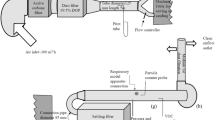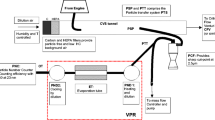Abstract
An inter-laboratory comparison of formaldehyde emission (FE) from laminated (PL) and uncoated (P2) particleboard (PB) with 16 mm thick-E1, used for non-structural and interior applications such as furniture materials and supplied from a commercial plant in the Czech Republic, was performed in two laboratories using the American small test chamber (ASTM D 6007-02). The results showed highly significant differences between the laboratories for PL (P<0.001), and not significant for P2 (P=0.33), and the differences between samples were significant for P2 and PL (P<0.05). The FE values ranged between 0.056 and 0.090 and from 0.088 to 0.099 ppm for PL and from 0.129 to 0.223 and from 0.175 to 0.182 ppm for P2 as measured in laboratories 1 and 2, respectively. There was a good correlation (R 2=0.84) between the formaldehyde values measured for both types of particleboards in the two laboratories. Most of the formaldehyde values were in agreement with the requirements of the California Air Resources Board (CARB) regulation. Furthermore, the results suggested that there was a higher homogeneity between the samples in laboratory 2 than in laboratory 1. The variation was related to the chamber conditions and sampling as well as inter-panel variations.
Zusammenfassung
Die Formaldehydabgabe (FE) aus beschichteten (PL) und unbeschichteten (P2) 16 mm dicken E1-Spanplatten (PB) für nicht tragende Verwendungen im Innenbereich, wie zum Beispiel Möbel, wurde in zwei Prüfstellen verglichen. Die Platten wurden von einer Firma in Tschechien geliefert und in der kleinen Prüfkammer nach ASTM D 6007-2 geprüft. Die Ergebnisse der zwei Prüfstellen unterschieden sich bei den beschichteten Platten stark signifikant (P<0,001) und bei den unbeschichteten Platten nicht signifikant (P=0,33). Bei beiden Prüfkörpertypen P2 und PL unterschieden sich die einzelnen Proben signifikant (P<0,05). Die Werte der Formaldehydabgabe lagen in Labor 1 bei den beschichteten Platten (PL) zwischen 0,056 und 0,090 ppm und bei den unbeschichteten Platten (P2) zwischen 0,129 und 0,223 ppm. In Labor 2 wurden Werte zwischen 0,088 und 0,099 ppm für PL und für P2 zwischen 0,175 und 0,182 ppm gemessen. Die in den beiden Laboren gemessenen Formaldehydwerte beider Plattentypen korrelierten gut (R 2=0,84). Die meisten der Werte erfüllten die Anforderungen der Luftreinhaltungskommission Kaliforniens (California Air Resources Board CARB). Daneben zeigen die Ergebnisse, dass die Proben in Prüfstelle 2 homogener waren als die Proben in Prüfstelle 1. Diese Schwankung wurde auf Unterschiede zwischen den Prüfkammern, die Probennahme sowie Unterschiede zwischen den Platten zurückgeführt.





Similar content being viewed by others
References
ASTM E 1333-96 (2002) Standard test method for determining formaldehyde concentrations in air and emission rates from wood products using a large chamber. American Society for Testing and Materials, West Conshohocken, PA, p 12
ASTM D 6007-02 (2002) Standard test method for determining formaldehyde concentration in air from wood products using a small-scale chamber. American Society for Testing and Materials, West Conshohocken, PA, p 8
Bulian F, Battaglia R, Ciroi S (2003) Formaldehyde emission from wood based panels: the importance of intercalibrating the test methods. Holz Roh- Werkst 61:213–215
CARB (2007) Proposed airborne toxic control measure (ATCM) to reduce formaldehyde emissions from composite wood products. http://www.arb.ca.gov/toxics/compwood/compwood.htm
CARB (2010) Results of international interlaboratory comparison of composite wood product third party certifiers (TPC). State of California, California Environmental Protection Agency, Air Resources Board
EN 120 (1993) Wood-based panels—determination of formaldehyde content—extraction method called perforator method. European Standard
EN 717-3 (1996) Wood-based panels—determination of formaldehyde release. Part 3. Formaldehyde release by the flask method. European Standard
EN 717-1 (2004) Wood-based panels—determination of formaldehyde release. Part 1. Formaldehyde emission by the chamber method. European Standard
Grigoriou A (1987) Formaldehyde emission from the edges and faces of various wood based materials. Holz Roh- Werkst 45(2):63–67
IARC (International Agency for Research on Cancer) (2004). Overall evaluations on carcinogenicity to humans. IARC Monographs, Vol. 1. International Agency for Research on Cancer, Lyon, France
JIS A1460 (2001) Building boards. Determination of formaldehyde emission—desiccator method. Japanese Industrial Standard
Kim S (2010) Control of formaldehyde and TVOC emission from wood-based flooring composites at various manufacturing processes by surface finishing. J Hazard Mater 176(1–3):14–19
Kim K-W, Kim S, Kim H-J, Park JC (2010) Formaldehyde and TVOC emission behaviors according to finishing treatment with surface materials using 20 L chamber and FLEC. J Hazard Mater 177(1–3):90–94
Nemli G, Öztürk İ (2006) Influences of some factors on the formaldehyde content of particleboard. Build Environ 41(6):770–774
NIOSH 3500 (1994) Formaldehyde by VIS; manual of analytical methods. 4th ed. National Institute of Occupational Safety and Health: Washington, DC
Pickrell JA Griffis LC Mokler BV et al (1986) Formaldehyde release rate coefficients from selected consumer products. In: Meyer, B, Andrews, B, Reinhardt, RM (eds), Formaldehyde release from wood products. American Chemical Society Symposium Series No. 385, Washington, DC, pp 40–51
Park B-D, Kang E-C, Park S-B, Park JY (2011) Empirical correlations between test methods of measuring formaldehyde emission of plywood, particleboard and medium density fiberboard. Eur J Wood Prod 69:311–316
Que Z, Furuno T (2007) Formaldehyde emission from wood products: relationship between the values by the chamber method and those by the desiccator test. Wood Sci Technol 41:267–279
Que Z, Furuno T, Katoh S, Nishino Y (2007) Evaluation of three test methods in determination of formaldehyde emission from particleboard bonded with different mole ratio in the urea-formaldehyde resin. Build Environ 42(3):1242–1249
Risholm-Sundman M (1999) Determination of formaldehyde emission with field and laboratory emission cell (FLEC)—recovery and correlation to the chamber method. Indoor Air 9:268–272
Risholm-Sundman M, Wallin N (1999) Comparison of different laboratory methods for determining the formaldehyde emission from three-layer parquet floors. Holz Roh- Werkst 57:319–324
Risholm-Sundman M, Larsen A, Vestin E, Weibull A (2007) Formaldehyde emission—comparison of different standard methods. Atmos Environ 41(5):3193–3202
Roffael E, Greubel D, Mehljorn L (1979) Über die Bestimmung der Formaldehydabgabe von Spanplatten nach dem Perforator-Verfahren und nach der WKI-Methode. Holz-Zentbl 104(24):396 –397
Salem MZM, Böhm M, Beránková J, Srba J (2011) Effect of some manufacturing variables on formaldehyde release from particleboard: relationship between different test methods. Build Environ 46(10):1946–1953
Salthammer T, Mentese S, Marutzky R (2010) Formaldehyde in the indoor environment. Chem Rev 110(4):2536–2572
SAS (2001) Users Guide: Statistics (Release 8.02). SAS Inst. Inc., Cary, NC, USA
Sundin EB, Mansson B, Endrody E (1987) Particleboard with different contents of releasable formaldehyde: a comparison of the board properties including results from four different formaldehyde tests. In: Proc of the 21st international particleboard/composite materials symposium. Washington State University, Pullman, pp 139–186
Wiglusz R, Jarnuszkiewicz I, Sitko E, Nikel G (2000) Interlaboratory comparison experiment on the determination of formaldehyde emitted from mineral wood board using small test chambers. Build Environ 35(1):53–57
Yrieix C, Dulaurent A, Laffargue C, Maupetit F, Pacary T, Uhde E (2010) Characterization of VOC and formaldehyde emissions from a wood based panel: results from an inter-laboratory comparison. Chemosphere 79:414–419
Acknowledgements
This work was financially supported by grants from the Internal Grant Agency, Faculty of Forestry and Wood Sciences, Czech University of Life Sciences, Prague. The authors acknowledge the contribution of the participating laboratories.
Author information
Authors and Affiliations
Corresponding author
Rights and permissions
About this article
Cite this article
Salem, M.Z.M., Böhm, M., Barcík, Š. et al. Inter-laboratory comparison of formaldehyde emission from particleboard using ASTM D 6007-02 method. Eur. J. Wood Prod. 70, 621–628 (2012). https://doi.org/10.1007/s00107-011-0593-4
Received:
Published:
Issue Date:
DOI: https://doi.org/10.1007/s00107-011-0593-4




